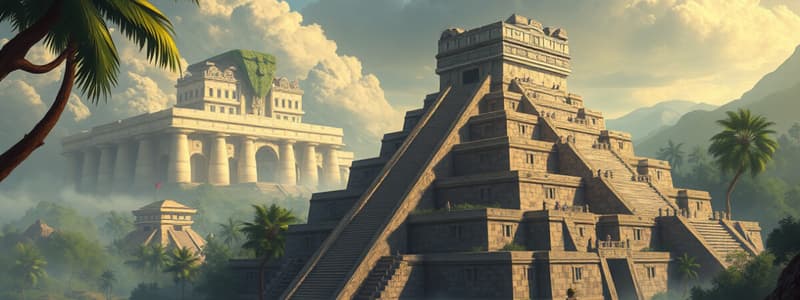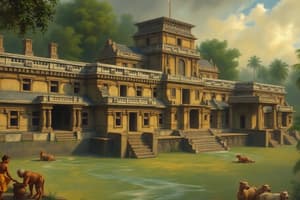Podcast
Questions and Answers
What was a primary reason for the decline of some Maya cities during the Classic period?
What was a primary reason for the decline of some Maya cities during the Classic period?
- Violent warfare between neighboring city-states (correct)
- Expansion of territory
- Invasion by the Spanish
- Increased trade with other civilizations
What writing system did the Maya civilization develop?
What writing system did the Maya civilization develop?
- Hieroglyphics using symbols for sounds and ideas (correct)
- An alphabet system similar to Latin
- A pictographic system without phonetic elements
- Cuneiform inscriptions on clay tablets
Under which empire did the Mexica people emerge as a powerful civilization?
Under which empire did the Mexica people emerge as a powerful civilization?
- Inca Empire
- Olmec Civilization
- Maya Empire
- Aztec Empire (correct)
Which of the following was a tool used by the Maya to document important information?
Which of the following was a tool used by the Maya to document important information?
What was a significant agricultural innovation of the Aztecs?
What was a significant agricultural innovation of the Aztecs?
What was the primary focus of the Mayan city-states?
What was the primary focus of the Mayan city-states?
What role did stelae play in Maya society?
What role did stelae play in Maya society?
Which of these was NOT a characteristic of Aztec daily life?
Which of these was NOT a characteristic of Aztec daily life?
What unique feature characterized the government of the Maya civilization?
What unique feature characterized the government of the Maya civilization?
What was one of the main goods traded by the Maya before Spanish colonization?
What was one of the main goods traded by the Maya before Spanish colonization?
How did the Inca view their ruler, the Sapa Inca?
How did the Inca view their ruler, the Sapa Inca?
Which of the following was the writing system used by the Maya civilization?
Which of the following was the writing system used by the Maya civilization?
What natural disaster is theorized to have contributed to the Maya's agricultural decline?
What natural disaster is theorized to have contributed to the Maya's agricultural decline?
What was a significant factor in the rapid fall of the Aztec Empire?
What was a significant factor in the rapid fall of the Aztec Empire?
How did the Maya keep track of time for longer periods?
How did the Maya keep track of time for longer periods?
What architectural feature was prominent in Mayan cities for worship purposes?
What architectural feature was prominent in Mayan cities for worship purposes?
What major factor contributed to the loss of early records of the Maya civilization?
What major factor contributed to the loss of early records of the Maya civilization?
During which time period did the Maya civilization notably exist?
During which time period did the Maya civilization notably exist?
Which sculpture is NOT one of Michelangelo's most famous works?
Which sculpture is NOT one of Michelangelo's most famous works?
What significant contribution did Johannes Gutenberg make around 1439?
What significant contribution did Johannes Gutenberg make around 1439?
What era is most closely associated with the rebirth of interest in Greek and Roman art and culture?
What era is most closely associated with the rebirth of interest in Greek and Roman art and culture?
During the Renaissance, how were religious figures typically depicted in art?
During the Renaissance, how were religious figures typically depicted in art?
What movement was sparked in 1517 by Martin Luther's actions?
What movement was sparked in 1517 by Martin Luther's actions?
What was the primary factor in the rise of the Inca Empire in the 15th century?
What was the primary factor in the rise of the Inca Empire in the 15th century?
What significant event contributed to the decline of the Inca Empire?
What significant event contributed to the decline of the Inca Empire?
Which method did the Inca use to adapt their farming techniques in the Andes Mountains?
Which method did the Inca use to adapt their farming techniques in the Andes Mountains?
What was the purpose of quipus in Incan culture?
What was the purpose of quipus in Incan culture?
What language did the Inca primarily speak?
What language did the Inca primarily speak?
What was one result of the arrival of Europeans in the Inca Empire?
What was one result of the arrival of Europeans in the Inca Empire?
What role did Atahualpa play in the history of the Inca Empire?
What role did Atahualpa play in the history of the Inca Empire?
How did the Inca communicate their identity and social status through textiles?
How did the Inca communicate their identity and social status through textiles?
What was a common geographic challenge faced by the Inca Empire?
What was a common geographic challenge faced by the Inca Empire?
What was the primary motivation for the Spanish conquest of the Inca Empire?
What was the primary motivation for the Spanish conquest of the Inca Empire?
What was a major event that contributed to the start of the Renaissance?
What was a major event that contributed to the start of the Renaissance?
Which city-state is known as the leading cultural center during the Renaissance?
Which city-state is known as the leading cultural center during the Renaissance?
Which family was known for their significant influence over Florence during the Renaissance?
Which family was known for their significant influence over Florence during the Renaissance?
What innovative invention during the Renaissance helped spread knowledge across Europe?
What innovative invention during the Renaissance helped spread knowledge across Europe?
Which artist is known for his work on the Sistine Chapel ceiling?
Which artist is known for his work on the Sistine Chapel ceiling?
What concept does humanism emphasize during the Renaissance?
What concept does humanism emphasize during the Renaissance?
Which work by Niccolò Machiavelli discusses the principles rulers should follow?
Which work by Niccolò Machiavelli discusses the principles rulers should follow?
What was the impact of Martin Luther's 95 Theses?
What was the impact of Martin Luther's 95 Theses?
Which painting by Sandro Botticelli exemplifies the merging of classic art themes with mythological subjects?
Which painting by Sandro Botticelli exemplifies the merging of classic art themes with mythological subjects?
Which of the following wars occurred during the Renaissance period?
Which of the following wars occurred during the Renaissance period?
Flashcards are hidden until you start studying
Study Notes
The Mayan Empire
- Thrived in Mesoamerica from 1800 BCE to approximately 900 CE, known for city-states and a sedentary lifestyle.
- Significant advancements in agriculture, religion, trade, and writing; had over 500 characters in their hieroglyphic writing system.
- Major trade items included jade, cacao, pottery, and obsidian; these items exchanged among city-states pre-Spanish colonization.
- City-states operated independently with local rulers known as Ajaw; no central king or emperor.
- Key structures included stepped pyramids for worship; calendars like the Round Count (52-year) and Long Count were used for planning.
- Decline linked to factors like climate changes, deforestation, drought, and warfare among cities, compounded by diseases introduced by the Spanish.
The Aztec Empire
- A military state in Central Mexico, led by the Mexica from the capital Tenochtitlán, formed through the Triple Alliance (Tenochtitlán, Texcoco, Tlacopan).
- The Mexica originated from Aztlán and established Tenochtitlán after being led by an omen of an eagle, snake, and cactus.
- The empire leveraged conquered territories through tributes, becoming one of the great civilizations with lasting cultural impact, especially in Mexico.
- Known for human sacrifices and advanced agricultural techniques, leading to high standards of living, especially for peasants.
- The conquest led by Hernán Cortés in 1519 and subsequent diseases contributed to the rapid decline of the Aztec Empire.
The Inca Empire
- Occupied the Andes Mountains of South America, where the Sapa Inca ruled as both a political and religious leader.
- The Inca began significant expansion in 1438 and included territories from Ecuador to Chile, often peacefully absorbing smaller kingdoms.
- Infrastructure included stepped agriculture for farming on mountains and a system of knotted strings called quipus for record-keeping, despite the lack of a written language.
- The empire collapsed due to smallpox introduced by Europeans, leading to civil war and the eventual capture of the last Sapa Inca, Atahualpa, by Francisco Pizarro.
Key Cultural Contributions
- The Maya, Aztec, and Inca civilizations made significant advancements in engineering, agriculture, and astronomy, despite geographical challenges.
- Monumental architecture characterized all three cultures, creating massive structures like pyramids and terraced farming in challenging terrains.
- The Renaissance, spanning from the 14th to 17th centuries in Europe, linked to the rediscovery of classical ideals and the rise of city-states like Florence.
- Innovators like the Medici family propelled Florence into a hub of art and education, marking a shift towards humanism and secularism in art.
- Important artistic figures included Michelangelo, Raphael, and Leonardo da Vinci, who utilized realism and human emotion in their works.
Renaissance Developments
- Inventions like the printing press revolutionized knowledge dissemination, leading to the Reformation and religious warfare.
- The overlapping Renaissance with wars like the Hundred Years' War and the Wars of the Roses shaped Europe's political landscape.
- Humanism influenced art, producing works such as Botticelli's "The Birth of Venus" and Michelangelo's biblical depictions, merging classic and religious themes.
- Significant thinkers like Martin Luther and Erasmus challenged established religious practices, fueling the Protestant Reformation and changing the Church's authority.
- Nicolaus Copernicus' heliocentric model revolutionized astronomy, contrasting the previous geocentric views and laying the groundwork for modern science.### Renaissance Art
- Use of perspective became a defining feature in Renaissance works, exemplified in Pierro della Francesca's "Flagellation of Christ."
- Mythological themes from ancient Greece and Rome were prevalent alongside Christian and secular themes in Renaissance painting.
- Religious figures in Renaissance art were portrayed in human-like forms, emphasizing relatability over grandeur.
Overview of the Renaissance
- The Renaissance was a cultural movement in Europe spanning the 14th to 17th centuries, meaning "rebirth."
- Emphasis on humanism characterized the Renaissance, highlighting renewed interest in classical Greek and Roman art and culture.
- Humanism values human actions and nature, asserting the importance of individual experience and intellect.
Innovations and Events
- The movable-type printing press, invented by Johannes Gutenberg around 1439, revolutionized the dissemination of knowledge and literature.
- The Age of Exploration marked a period of significant global exploration, peaking from the late 15th to the 17th centuries.
- The Protestant Reformation began in 1517 when Martin Luther, a monk, initiated an anti-Catholic movement, leading to substantial shifts in European politics and society.
Studying That Suits You
Use AI to generate personalized quizzes and flashcards to suit your learning preferences.




